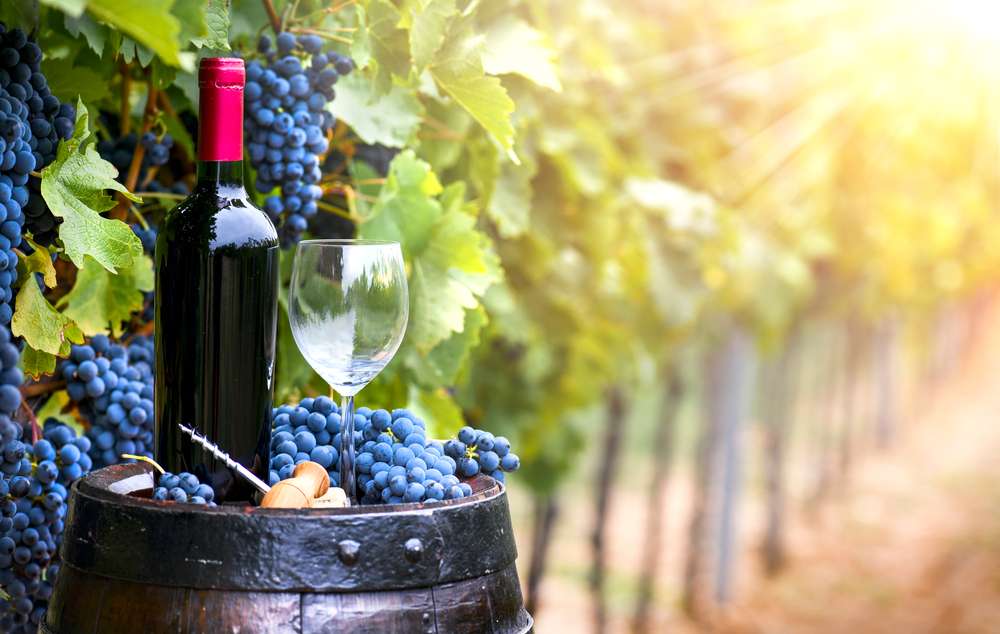Take a sip of Burgundy and step into a world of flavors. This region in eastern France offers a symphony for the palate, just waiting to be tasted. Journey with us through Burgundy’s picturesque vineyards, where we’ll uncover the stories behind its famous wines, delve into the heart of its terroir, and savor the essence of its most celebrated bottles. Get ready to be enchanted by the liquid gold of Burgundy!
Astonishing Facts About Burgundy
You’ve probably heard of Burgundy and its reputation for producing incredible wines. But did you know that Burgundy’s story goes far beyond just grapes? Prepare to be amazed as we uncover the hidden gems and fascinating tales woven into the fabric of this captivating region.
From Barbarian Tribes to Powerful Dukes: A History You Won’t Believe
Centuries ago, a group of Germanic tribes known as the Burgundians claimed this land as their own, leaving an indelible mark on the region’s identity. Over time, Burgundy transformed into a powerful duchy, wielding significant influence and wealth in medieval France. Its strategic location made it a vibrant crossroads, bustling with trade routes and welcoming pilgrims from distant lands, resulting in a rich tapestry of cultures.
Wine Secrets: Unveiling the Magic of Burgundy’s Vines
Burgundy’s reputation for exceptional wines is deeply rooted in its unique terroir—the intricate interplay of soil, climate, and human touch. This region is the birthplace of Pinot Noir and Chardonnay, two of the world’s most beloved grape varietals. Each vineyard possesses a distinct personality, shaped by subtle variations in soil composition, microclimates, and generations of winemaking expertise, giving rise to wines of unparalleled complexity and depth.
A Journey Through Time: Exploring Burgundy’s Architectural Wonders
Step back in time as you explore Burgundy’s architectural treasures. Majestic medieval castles, such as the Châteauneuf-en-Auxois, seem to rise straight out of fairytales, while the serene Abbaye de Cîteaux whispers tales of centuries past. Charming villages, like Flavigny-sur-Ozerain and Vézelay, offer a glimpse into a bygone era, with their cobblestone streets and ancient churches. From awe-inspiring Romanesque architecture to the opulence of Renaissance palaces, Burgundy’s architectural tapestry reflects a rich and vibrant past.
What is a Fact About Burgundy?
Burgundy, often called the “Heart of France,” is more than just a name. It’s a region steeped in history, bursting with culture, and renowned for its exceptional wines. Here’s a fact you might not know: Burgundy boasts over 100 appellations—specific geographical areas recognized for producing unique and high-quality wines. Each appellation possesses its own distinct terroir, contributing to the incredible diversity and world-renowned reputation of Burgundy wines.
And let’s not forget about the food! Burgundy is a culinary paradise, famous for its melt-in-your-mouth Beef Bourguignon and an impressive array of artisanal cheeses, each with its own distinct character. These culinary delights perfectly complement the region’s exceptional wines, creating a symphony of flavors.
Burgundy’s commitment to viticulture is evident in its centuries-old “Climats” system—a UNESCO World Heritage site—meticulously dividing vineyards based on factors like grape varietals, soil types, and sun exposure. This intricate system reflects Burgundy’s dedication to producing the finest wines, showcasing the region’s deep respect for its terroir.
Imagine rolling hills carpeted in vineyards, charming medieval towns frozen in time, and majestic castles peeking through the foliage. Burgundy’s picturesque landscapes are a photographer’s dream come true, offering a captivating blend of natural beauty and architectural splendor.
Why is Burgundy so Special?
What makes a bottle of Burgundy so special? What sets this region apart as the holy grail for wine lovers worldwide? Let’s delve into the reasons behind Burgundy’s unparalleled allure.
Imagine a tapestry woven from threads of weather patterns, soil compositions, and the lay of the land. This tapestry is what we call terroir—and in Burgundy, it’s unlike anywhere else on Earth. Burgundy’s terroir is as unique as a fingerprint, giving each vineyard its own distinct story to tell. Two vineyards side-by-side can produce wines that taste vastly different, all thanks to the nuances of their terroir.
We can’t talk about Burgundy without mentioning the monks. These dedicated individuals were the original winemakers of Burgundy, carefully cultivating vines and refining techniques over centuries. Their legacy is still felt today, with many top vineyards located on land once owned by these wine-loving monks.
But Burgundy’s specialness extends far beyond wine. Steeped in history, boasting stunning architecture, and offering a culinary scene to tantalize any palate, Burgundy is a feast for all the senses. During the Middle Ages, the powerful Duchy of Burgundy flourished in this region, leaving behind grand castles and charming villages.
Here’s the Essence of Burgundy’s Magic:
- Terroir: Burgundy’s unique terroir imparts a distinctive personality to each wine.
- Monastic Legacy: Centuries of winemaking tradition, passed down through generations of monks, continue to shape the region’s winemaking practices.
- A Sensory Feast: Beyond the wine, Burgundy captivates with its history, art, and delectable cuisine.
It’s no wonder people are enchanted by Burgundy. Every sip of wine whispers a story, and every cobblestone street echoes tales of a rich and captivating past. A visit to Burgundy is an experience you won’t soon forget.
Want to explore further? Visit www.bourgogne-wines.com.
What is Burgundy Best Known For?
If you’re a foodie or a wine enthusiast, Burgundy is a dream destination. Let’s delve into what makes this region a true gem.
Gastronomic Delights:
Prepare to be amazed by Burgundy’s culinary scene. Savor the delicate flavors of escargots à la bourguignonne, snails cooked to perfection with garlic, butter, and parsley. Indulge in the rich and savory boeuf bourguignon, a beef stew slow-cooked in red wine, mushrooms, and bacon—a true comfort food classic. And don’t miss the opportunity to elevate any dish with the renowned Dijon mustard, crafted from brown mustard seeds—a true testament to Burgundy’s culinary prowess.
World-Class Wines:
Burgundy is a wine lover’s paradise, home to some of the most celebrated wines globally. Pinot Noir, known for its delicate flavors and velvety texture, and Chardonnay, ranging from crisp and refreshing to rich and buttery, reign supreme in this region. The picturesque vineyards aren’t just a feast for the eyes; they produce some of the most exceptional wines you’ll ever taste.
Beyond the Glass:
Burgundy’s allure extends beyond its culinary delights. The region boasts a captivating blend of history, architecture, and natural beauty. Picture medieval castles perched on rolling hills, gothic cathedrals reaching for the heavens, and charming villages that feel as if they’ve been plucked straight from the pages of a storybook.
For nature enthusiasts, Burgundy offers a picturesque escape. Cycle through sun-drenched vineyards, hike through lush forests, or simply unwind with a picnic amidst breathtaking views. Burgundy’s landscapes are a testament to the beauty of rural France, offering a tranquil escape from the hustle and bustle of city life.
Here’s a Taste of Burgundy’s Charms:
- Gastronomy: Indulge in culinary delights like escargots, boeuf bourguignon, and Dijon mustard.
- World-Class Wines: Experience the exceptional flavors of Pinot Noir and Chardonnay, crafted with centuries of tradition.
- Architectural Wonders: Discover a tapestry of castles, cathedrals, and charming villages.
- Breathtaking Scenery: Immerse yourself in rolling vineyards and picturesque landscapes, perfect for exploration.
If you’re seeking a destination that tantalizes all the senses, Burgundy should be at the top of your list!
What are the Traits of Burgundy?
Burgundy, a region in eastern France, is a treasure chest overflowing with history, flavor, and captivating landscapes. Here, the past seamlessly merges with the present, creating an enchanting and inviting atmosphere.
A Tapestry of History:
Imagine stepping back in time as you wander through the ancient halls of Vézelay Abbey or stroll along the charming streets of Dijon. These living, breathing testaments to Burgundy’s past offer a glimpse into a bygone era, whispering tales of medieval grandeur and cultural richness.
A Toast to the Vines:
Burgundy is practically synonymous with exceptional wines, particularly its Pinot Noir and Chardonnay. The secret lies in the terroir—the intricate interplay of soil, climate, and environment that gives Burgundy wines their unparalleled depth and complexity. No wonder wine lovers from around the globe consider Burgundy a pilgrimage site.
One of the most fascinating aspects of Burgundy’s viticulture is its “Climats” system. Picture meticulously divided plots of land, each with its own unique characteristics, history, and potential—all meticulously documented and passed down through generations.
Indulge Your Senses:
Burgundy is about savoring life’s simple pleasures—indulging in a plate of escargots bathed in garlic butter, surrendering to the rich flavors of boeuf bourguignon, or discovering the perfect cheese pairing for a glass of local wine. From creamy Époisses to tangy Citeaux, Burgundy’s cheesemaking tradition is just as impressive as its viticulture.
Embrace Nature’s Embrace:
Beyond the cellars and kitchens, Burgundy invites you to explore its natural wonders. Cycle through rolling hills blanketed in vineyards, hike through the lush Morvan Regional Natural Park, or simply bask in the tranquility of a landscape painted with vineyards and ancient forests.
Burgundy is a captivating blend of history, culture, and natural splendor—a region that encourages you to slow down, savor each moment, and uncover the hidden gems nestled within its ancient villages, sprawling vineyards, and captivating landscapes.
What Emotion is the Color Burgundy?
Burgundy, a color that sits between red and purple, evokes a fascinating mix of emotions, much like the region it’s named after. Let’s explore the evocative power of this rich and captivating hue.
Love and Passion:
Burgundy often stirs feelings of love and passion, perhaps because it reminds us of velvety roses, decadent chocolates, and romantic evenings. It’s no coincidence that burgundy is a popular color for Valentine’s Day!
Luxury and Sophistication:
Imagine luxurious velvet curtains in a grand theater, an expensive bottle of wine, or a plush chair in an old mansion. Burgundy whispers of wealth, elegance, and good taste. Its presence adds an air of sophistication to any setting.
Royalty and Power:
For centuries, burgundy has been linked to royalty and power. Kings and queens donned burgundy attire to project an aura of authority and importance. This association with the upper echelons of society likely contributes to its air of confidence and refinement.
Religion and Spirituality:
Burgundy also has ties to religion and spirituality, often appearing in religious art to represent the blood of Christ. This connection adds another layer to burgundy’s emotional range, linking it to ideas of reflection, sacrifice, and the possibility of redemption.
A Versatile Hue:
Burgundy’s appeal transcends historical and cultural associations. It’s a versatile color that can be warm and inviting or cool and mysterious, depending on how it’s used. It’s a popular choice for fashion, makeup, and home decor, adding a touch of richness and depth to any space.
The Impact of Burgundy:
Think about how burgundy makes you feel. Its richness and depth might evoke feelings of coziness and contentment, similar to its bolder counterpart, red. But because it’s darker and more subdued, burgundy can also evoke feelings of sadness or melancholy.
It’s important to remember that color psychology is not an exact science. Our experiences, cultural backgrounds, and personal preferences influence how we perceive colors. So, while there might be common associations with burgundy, your own interpretation might be different.
Ultimately, burgundy is a complex and captivating color, rich in history and brimming with emotional depth. It can be luxurious and spiritual, passionate and somber—a color that continues to intrigue and inspire, much like a fine glass of Burgundy wine.
What is the Symbol of Burgundy?
Let’s uncover intriguing facts about this celebrated French region, known for its history and legendary wines.
The Cross of Burgundy: A Badge of Honor
Imagine a bold diagonal cross set against a crisp white background. This is the Cross of Burgundy, a symbol deeply intertwined with the region’s past. Once proudly displayed on the battle flags of the mighty Dukes of Burgundy during the Middle Ages, this emblem served as a royal seal of approval. Today, it remains a source of regional pride, a visual testament to Burgundy’s rich heritage.
A Legacy in Every Glass: Burgundy’s Extraordinary Wines
Burgundy’s vineyards are a sight to behold, but what makes them truly special is the intricate network of over 100 appellations—designated areas recognized for producing wines of exceptional quality. This intricate patchwork of terroirs gives rise to a remarkable diversity of wines, showcasing the nuances of each vineyard. And from these meticulously tended vines come some of the world’s most sought-after wines, including the elegant Pinot Noir and the buttery Chardonnay. Each bottle reflects a unique terroir and centuries-old winemaking traditions.
Beyond the Wine Glass: A Culinary Adventure Awaits
Don’t be fooled into thinking Burgundy is only for wine lovers. This region is a foodie’s paradise, home to culinary delights that will tantalize your taste buds. Imagine savoring a hearty Boeuf Bourguignon, a traditional beef stew slow-cooked in red wine, or indulging in escargots à la Bourguignonne, snails prepared with garlic and parsley butter. And what better way to elevate these classic dishes than by pairing them with—you guessed it—some of Burgundy’s finest wines?
Stepping Back in Time: History and Architecture
Burgundy’s strategic location at the crossroads of history has resulted in a rich tapestry of cultures and architectural marvels. As you explore the region, you’re transported back in time. Magnificent medieval castles stand as proud sentinels, ancient abbeys whisper tales of centuries past, and charming villages seem frozen in time, their cobblestone streets and ancient buildings whispering secrets of a bygone era.
Burgundy: A Tapestry of History, Wine, and Culinary Delights:
- Symbol: The instantly recognizable Cross of Burgundy reflects the region’s rich heritage.
- Vineyards: Burgundy’s diverse vineyards, divided into over 100 appellations, produce some of the world’s most sought-after wines.
- Iconic Wines: Pinot Noir and Chardonnay take center stage, celebrated for their elegance, complexity, and ability to age gracefully.
- Culinary Tradition: Burgundy boasts a rich culinary tapestry, featuring dishes that pair perfectly with the region’s exceptional wines.
- Architectural Heritage: From medieval castles to historic abbeys, Burgundy’s architectural treasures offer a glimpse into its fascinating past.
Your journey into the heart of Burgundy has just begun. Uncork a bottle, savor the flavors, and delve into the rich history and culture of this captivating region.
How Did Burgundy Get Its Name?
The name “Burgundy” didn’t just magically appear. It carries a fascinating history that dates back to the days of migrating tribes and the fall of the Roman Empire.
Imagine a time when the Roman Empire was in decline, and tribes from the east were on the move. In the 5th century, one such tribe, the Burgundians, an East Germanic people, ventured westward in search of a new homeland. They eventually settled in the Rhône valley, establishing their own kingdom, which they named after themselves—Burgundy.
As centuries passed and empires rose and fell, the political boundaries of Europe shifted numerous times. However, the name “Burgundy” remained attached to the region, a testament to the lasting impact of these ancient settlers.
Key Takeaways:
- The name “Burgundy” originates from the Burgundian tribe, who migrated to the region in the 5th century.
- These Germanic people established their own kingdom, which they named after themselves.
- Despite political changes over the centuries, the name “Burgundy” has endured, reflecting the region’s historical roots.
How Did Burgundy Color Get Its Name?
We know that the color burgundy is named after a certain region in France, famous for it’s exceptional wines. But how did this connection come to be? The answer lies in a fascinating journey through history, ancient travelers, and a shared love for a particular beverage.
Taking it Back to the Source
Let’s rewind to the late Roman Empire. As the empire weakened, a tribe called the Burgundians, originally from the east, decided to head west in search of a new home. They eventually established their own kingdom in what we now know as the Rhône valley and parts of western Switzerland. And, you guessed it, they called it Burgundy!
From Grape to Great Color
Now, let’s talk about what Burgundy is arguably most famous for—wine, specifically, its deep, complex red wines. For centuries, people have been captivated by the unique flavors and characteristics of Burgundy wine. Over time, the color itself became associated with this luxurious drink.
Burgundy Crosses the Channel
In the fashion-forward world of late 19th century England, the name “burgundy” was officially adopted as a color name, solidifying its place in the world of style. Its association with luxurious French wine gave it an air of elegance and sophistication. And so, burgundy began appearing in fashion, home decor, and art—anything that needed a touch of richness and refinement.
A Color with Two Names?
Here’s where things get a little interesting. In English, we call it “burgundy.” But in French, the color is often referred to as “Bordeaux,” after another famous wine region in France known for its incredible red wines. It seems the French couldn’t resist naming a color after their beloved wines—twice!
More than Just a Pretty Hue
Burgundy is more than just a color, it’s a feeling—a representation of warmth, passion, and luxury. In fashion, it makes a statement. It says you’re confident, elegant, and have a taste for the finer things in life. And because of its historical ties to royalty, power, and wealth, burgundy remains a popular choice for high-end fashion and luxurious interiors.
Want to delve deeper into the history of Burgundy wine? Check out this fascinating podcast episode: “The History of Burgundy Wine: From the Burgundians to the French Revolution.” Historia: The Podcast for Historians. Accessed March 8, 2023.
Does Burgundy Age?
Like a fine antique, Burgundy wine is known for its ability to age gracefully, developing complexity and depth over time. But what is it about Burgundy that makes it so well-suited to the aging process? Let’s uncover the secrets behind this time-honored tradition.
Think of Burgundy wine as a time capsule, capturing the essence of a specific time and place—the climate, the soil, the winemaker’s touch. Burgundy wines are crafted to evolve, revealing new layers of aroma and flavor as they mature.
Factors Contributing to Burgundy’s Aging Potential:
- Terroir: This French term encompasses the unique environmental factors that influence grape growing, such as soil type, climate, and altitude. Burgundy’s diverse terroir—from limestone-rich slopes to clay-based soils—plays a crucial role in the aging potential of its wines.
- Winemaking Techniques: Burgundy winemakers often employ traditional winemaking methods that prioritize minimal intervention, allowing the grapes to express their natural character. These techniques contribute to the wine’s structure and balance, which are essential for aging.
- Tannins and Acidity: Tannins, naturally occurring compounds found in grape skins, seeds, and stems, provide structure and aging potential. Burgundy wines, particularly reds, are known for their firm tannins, which soften and integrate over time, resulting in a smoother, more velvety texture. Acidity, another crucial component, acts as a preservative and contributes to the wine’s freshness and longevity.
The Transformation of Time:
As Burgundy wines age, they undergo a fascinating transformation:
- Tannin Evolution: Harsh tannins soften and integrate, giving way to a silkier, more velvety texture.
- Flavor Development: Primary fruit flavors, such as red berries and black cherries, evolve into more complex notes of dried fruits, spices, earth, leather, and tobacco, adding layers of intrigue to the wine’s profile.
- Increased Complexity: The wine’s aromas and flavors become more integrated and harmonious, creating a symphony of nuances that captivate the senses.
Patience is Key:
Aging Burgundy wine requires patience and proper storage conditions. A cool, dark cellar with consistent temperature and humidity is ideal. While some Burgundy wines can age for decades, others might reach their peak within a few years. Consulting vintage charts, wine experts, and trusted resources can help you determine the optimal aging potential of specific bottles.
Want to Embark on Your Own Aging Adventure?
- Connect with Wine Experts: Sommeliers or knowledgeable wine merchants can recommend Burgundies well-suited for aging and provide insights into specific vintages.
- Attend Wine Tastings: Tastings offer a fantastic opportunity to sample different Burgundy wines and vintages, allowing you to experience firsthand how aging influences their flavor profiles.
- Do Your Research: Explore reputable online resources such as Wine Folly and Wine Spectator, where you can find detailed information about Burgundy wines, vintages, and aging potential.
Remember, aging wine is an adventure—one that involves experimentation, patience, and the joy of discovery. So, acquire a bottle (or two) of Burgundy, create the ideal storage conditions, and embark on your own personal aging journey!
What is the True Color of Burgundy?
Burgundy, that rich, elegant color, presents a bit of a challenge when it comes to describing it accurately. It’s red, but deeper, richer, and more complex than your average crimson. It has hints of purple but lacks the vibrancy of a true violet. Burgundy exists in a fascinating space between these two hues, making it difficult to pin down its exact identity.
Some people use terms like “brownish” or “earthy” to describe its depth and complexity. Others reach for words like “royal,” “opulent,” or “luxurious” to encapsulate its air of sophistication and refinement.
The truth is, burgundy is a bit of a chameleon. It changes depending on the lighting, the material it’s on, and even the colors surrounding it. The interplay of light and shadow can make it appear more red or more purple, warmer or cooler, brighter or more subdued. This ever-shifting nature is part of what makes burgundy so captivating.
So, what is the true color of burgundy? Perhaps the best answer is that it’s a beautiful, enigmatic blend that continues to intrigue and fascinate. It’s a color that defies easy categorization, inviting us to explore its depths and appreciate its complexities.
Did you know that Thursday got its name from the Norse God of Thunder? Dive into more fascinating tidbits about Thursday by clicking on fun facts about thursday. Or you can learn about Tuesday whose name origin is also rooted in Norse mythology. Even more, go deeper into mythology by exploring the shadoof – an ancient Egyptian water-lifting device named after the Egyptian God, Show.
- Unveiling Bernhard Caesar Einstein’s Scientific Achievements: A Legacy in Engineering - July 15, 2025
- Uncover who is Jerry McSorley: CEO, Family Man, Business Success Story - July 15, 2025
- Discover Bernhard Caesar Einstein’s Scientific Contributions: Unveiling a Legacy Beyond Einstein - July 15, 2025















